 Tile installation is probably the most complex of all floor installation. Part of that is due to tile not going solely on floors, but in showers, walls, backsplashes, ceilings, around fireplaces, inside and outside, and pretty much anywhere else you can put a flat, or even curved, surface. There is also a wider range in types of tile, sizes, installation methods, and so many variables it would be impossible to give you a comprehensive list. Below is a whole bunch of information that you might find useful.
Tile installation is probably the most complex of all floor installation. Part of that is due to tile not going solely on floors, but in showers, walls, backsplashes, ceilings, around fireplaces, inside and outside, and pretty much anywhere else you can put a flat, or even curved, surface. There is also a wider range in types of tile, sizes, installation methods, and so many variables it would be impossible to give you a comprehensive list. Below is a whole bunch of information that you might find useful.
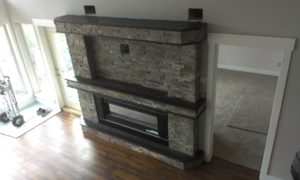 The quality will vary with the price for tile. This is broken down between two areas, the quality of the materials and the quality of the installation.
The quality will vary with the price for tile. This is broken down between two areas, the quality of the materials and the quality of the installation.
The mortar and grout is normally payed for by the installer, and varies in cost depending on application. Grout costs vary in the same way just for the material, with standard cement based grouts to premium fusion/flexcolor grouts, and even epoxy grouts.
For a quality installation you need a flat, well prepared surface, and material costs for leveling vary between very inexpensive to incredibly costly. If one company quotes at 50% less then someone else, expect that he or she will likely be using lower quality materials, or not including prep in the quote, which may be a surprise add on.
The quality of the installation is so varied between companies it can be hard to compare costs. Less qualified installers often have very large grout lines to hide inconsistency in their installation, particularly if they haven’t done proper surface prep and leveling, and the need to hide lippage (difference in height) between tiles. Industry standards for differences in height between tiles is 1/16 of an inch, plus the variance in the tile itself. If you require a quality above industry standards, it is important to communicate that to the company ahead of time. Some companies don’t have the experience to deliver on demanding jobs, and those that do will need to know your expectations to estimate the cost and time accurately, and make sure you’re happy with the final product.
Some tiles will not allow very small grout lines or perfectly flat/smooth finished floors, due to variance in size from tile to tile. Rectified tiles are the best for 1/8 and under grout lines.
There are other variables for quality as well. If you are having a shower installed, building code is lower then industry standards when it comes to waterproofing, and can lead to mold growth and structural damage unless care is taken. Having a crack isolation mat put down can help a floor last longer in areas where there may be movement in the substrate, such as in basements. Sound barriers for tile are a requirement in most condos and apartments, and the cost of these can vary. Heated floors can are a great luxury, and keep your bare feet comfortable.
 Because the quality and speed of installation for tile is linked, you may have to plan farther ahead to get the installation you deserve. Tile takes longer then most other floors to install for the same area, and many are surprised at how long a tiled custom shower takes from start to finish, but it is important that every step is done correctly, which takes time.
Because the quality and speed of installation for tile is linked, you may have to plan farther ahead to get the installation you deserve. Tile takes longer then most other floors to install for the same area, and many are surprised at how long a tiled custom shower takes from start to finish, but it is important that every step is done correctly, which takes time.
Plan ahead when looking for a tile setter, so you don’t end up needing to settle for a less qualified installer when your first choices aren’t available. Try to plan exterior work during warmer months, as mortars and epoxy don’t cure properly in subzero conditions.
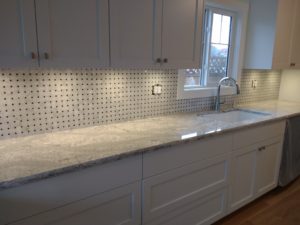 The range of costs will vary greatly. The main factors to consider are the size of the tiles, where they are being installed (floor, wall, shower, interior or exterior), they type of tile, the pattern or layout of the tile, the prep that needs to be done before installation, if the tile and/or grout needs to be sealed, if you need crack isolation, waterproofing, or decoupling membranes.
The range of costs will vary greatly. The main factors to consider are the size of the tiles, where they are being installed (floor, wall, shower, interior or exterior), they type of tile, the pattern or layout of the tile, the prep that needs to be done before installation, if the tile and/or grout needs to be sealed, if you need crack isolation, waterproofing, or decoupling membranes.
Floor tile will often be the low end of price for location of the tile, with wall tile being more expensive, and exterior tile the most expensive. Areas with many cuts, particularly showers, will cost more per square foot then a large flat feature wall. Exterior tiles require a higher quality mortar, and a higher percentage of coverage then interior tiles. Advertised prices are for interior floor tile unless otherwise specified.
Porcelain and ceramic are the low end of cost for type of tile, glass and natural stones being more expensive. The specific type of natural stone can affect the price, as some require extra work with sealing before installation, before grouting, etc. Some also require very specific considerations, such as green marble, which is highly susceptible to warping from moisture. Ledgestone/stacked stone looks amazing around a fireplace or on a feature wall, but doesn’t work well on horizontal surfaces, and often needs it’s corners mitered. Patterns and layouts will add to the cost per square foot depending on the expected extra time it will take. Layout refers more to how many cuts will be required, with the areas requiring a lot of cuts costing more, and patterns being repeating, or random, that will take more time to install. Advertised prices are normally based on straight or offset patterns unless otherwise specified.
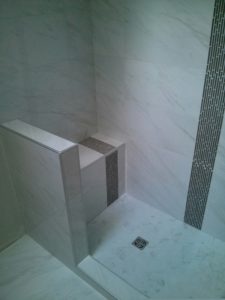 The substrate needs to be flat, clean of contaminants, and of a proper bondable material for the mortar. Oil based residues will need to be removed, sealed concrete will need to be prepared so the mortar will adhere, and some wood substrates like OSB will need to be either replaced or prepared with an appropriate membrane. Standard size tiles require the normal 1/8” over 10 feet flatness requirement, and larger tiles will often require an even flatter surface for a flat finished floor. Leveling and surface preparation is essential in a high quality tile installation and is an additional cost.
The substrate needs to be flat, clean of contaminants, and of a proper bondable material for the mortar. Oil based residues will need to be removed, sealed concrete will need to be prepared so the mortar will adhere, and some wood substrates like OSB will need to be either replaced or prepared with an appropriate membrane. Standard size tiles require the normal 1/8” over 10 feet flatness requirement, and larger tiles will often require an even flatter surface for a flat finished floor. Leveling and surface preparation is essential in a high quality tile installation and is an additional cost.
Sealing is normally not necessary when dealing with man made tile, as the tile itself will normally not be porous, although the grout likely will be. Almost all natural stones will benefit from sealing, and most installers will include the cost in this in your quote, either rolled in or separately in case you would like to do the sealing yourself. Some natural stones actually benefit from sealing before installation, or after installation but before grouting.
Crack isolation membranes and waterproofing are sometimes suggested or required. Showers require waterproofing, and we highly recommend you only hire someone with licensing and insurance to waterproof your shower, as it can cost tens of thousands in repairs to your house if done wrong.
Tile requires a thicker wood sub floor for structural rigidity then any other type of flooring. Most homes have a 3/4” thick sub floor when they are built, and tile requires a 1 1/8” thick sub floor. Installing on a thinner sub floor may cause tiles to come loose or crack with time. A superior option is to use an uncoupling membrane such as Schluter Ditra, which will not raise your final floor height as much, and offers other benefits such as uncoupling the tile from the substrate, increases load impact, can be waterproofed easily by waterproofing the seams, and equalizes the vapor pressure.
The transitions, and edges of wall tile, are something that needs to be considered as well. On wall tile, where there will be a visible edge of the tile, you have an option of putting a decorative and protective trim, or having the edge of the tile visible. More delicate tile benefits more from these metal trims, while ledgestone almost never has any trim. Most doorways and transitions to other types of flooring will also require trim. There are different styles and colors to choose from.
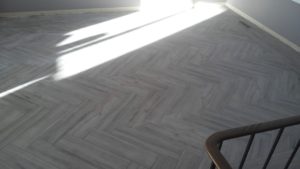 Current floor removal
Current floor removal
Tile has strict requirements for what substrates it can be installed on. We recommend only installing on tile backer board, exterior grade plywood, properly prepared concrete, and tile specific membranes. You can install over top of other surfaces if certain conditions are met. This means that most of the time your current floor will have to be removed before tiling can take place. Tile can be installed on top of old tile, if it’s well secured, with a proper primer applied before tiling.
A product from Ardex allows for a floating tile installation in instances where your current hard surface is not suitable for installation of tile, or is unsafe to remove, such as in the case of asbestos flooring. It is also great for commercial tile installations that may be replaced at regular intervals.
Substrate prep
Industry standard for floor flatness tolerance in tile installation is 1/8” over 10”, though larger tiles require up to 1/16” over 10”. If the floor is not flat enough, it is possible you will have hollow spots under tiles that will cause cracks and damage in the long run, and frequently leads to excessive lippage, which is a difference in height between tiles.
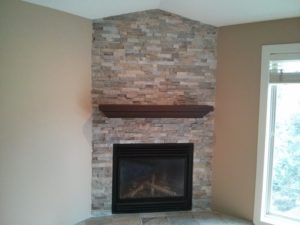 Furniture and appliance removal and replacement
Furniture and appliance removal and replacement
Furniture moving is often charged per room, or per hour, appliance moving is often charged per appliance. If anything with gas or water lines need to be moved, you will need someone qualified to unhook them and hook them back up.
Baseboard removal and replacement
When any floor except carpet is installed, the baseboard needs to come off and be put back on at the new proper height. Another option with tile is to have tile baseboard installed, which is charged per linear foot.
Garbage removal
We include removal of garbage and waste in our quote. If you have a garbage bin on site, let us know and we can account for that in our quote.
Material
The tile material is always separate from installation costs, unless specified. We have installed material from most flooring stores in Kelowna, and can pick up and deliver the material to the installation site.

